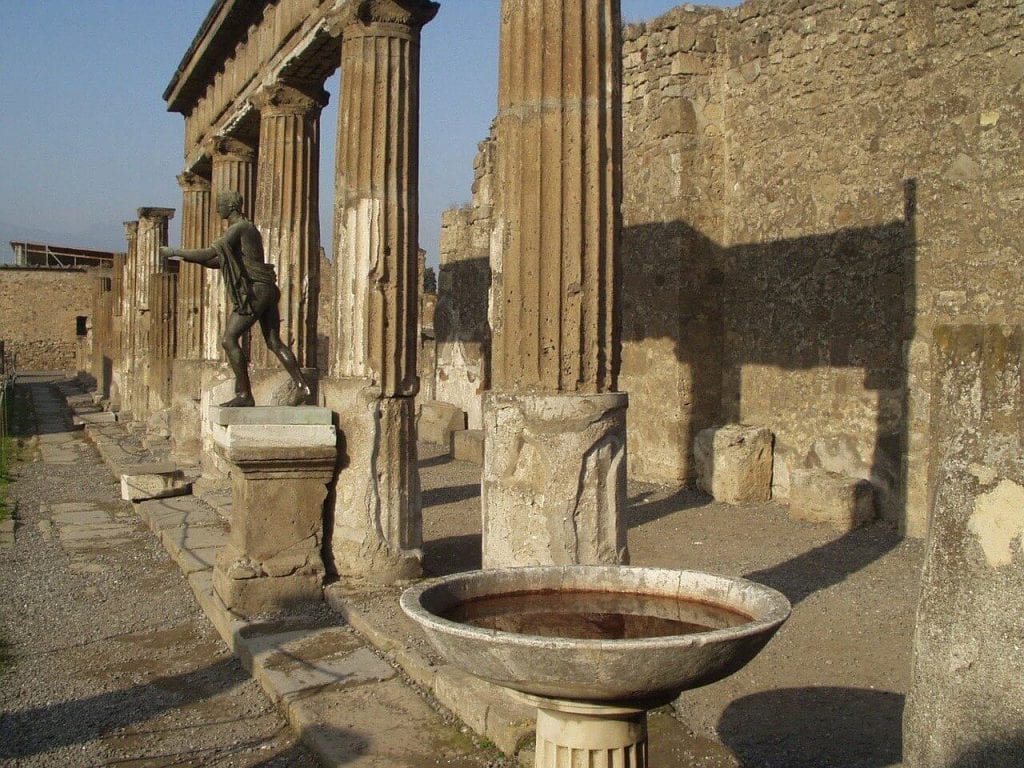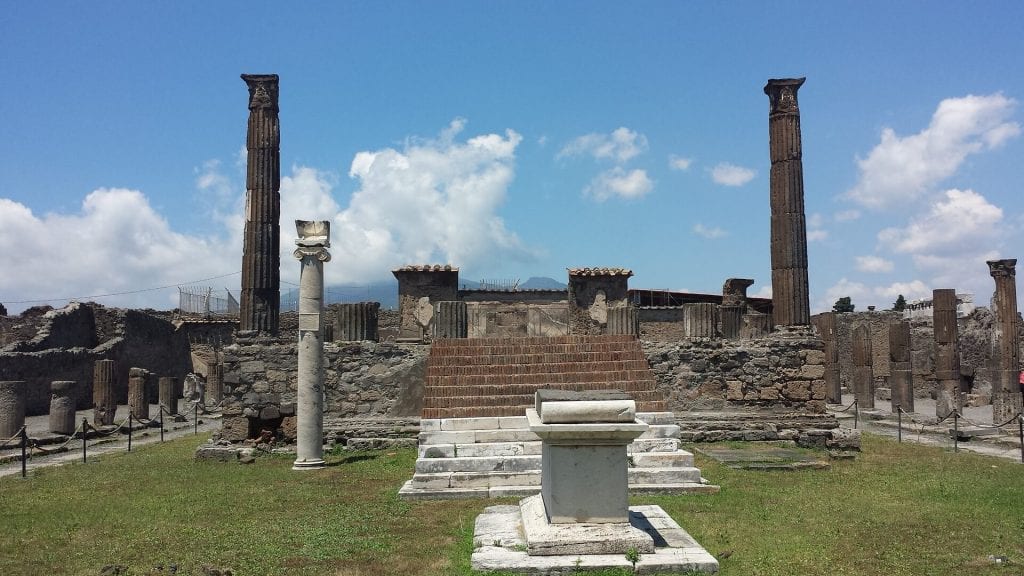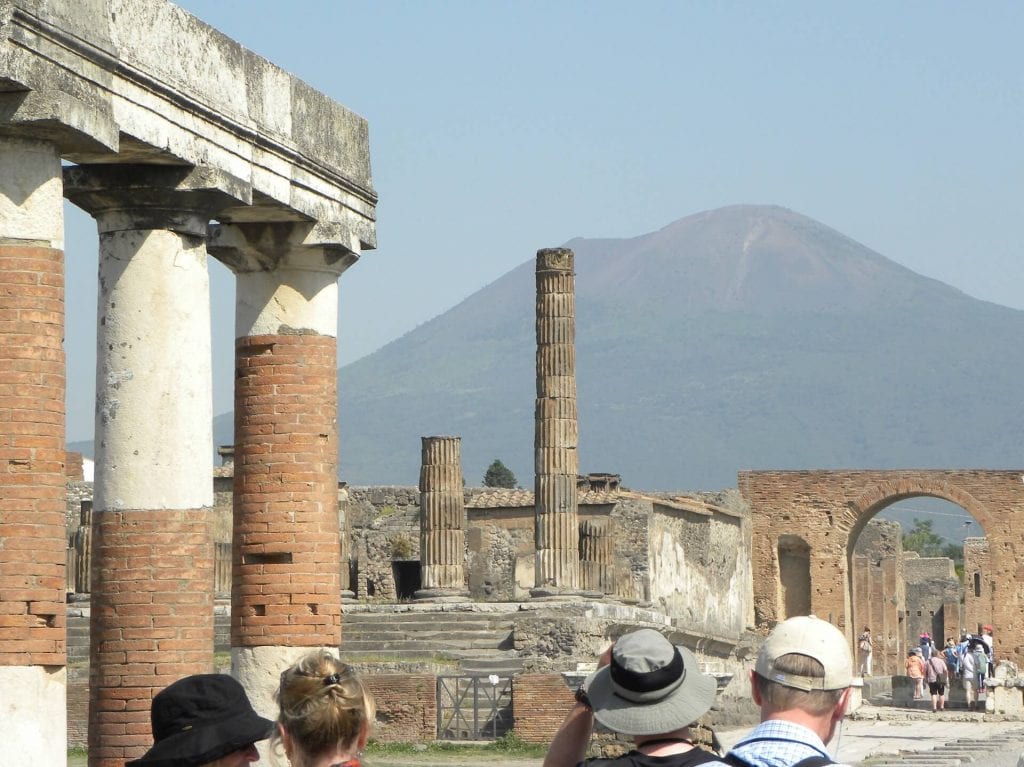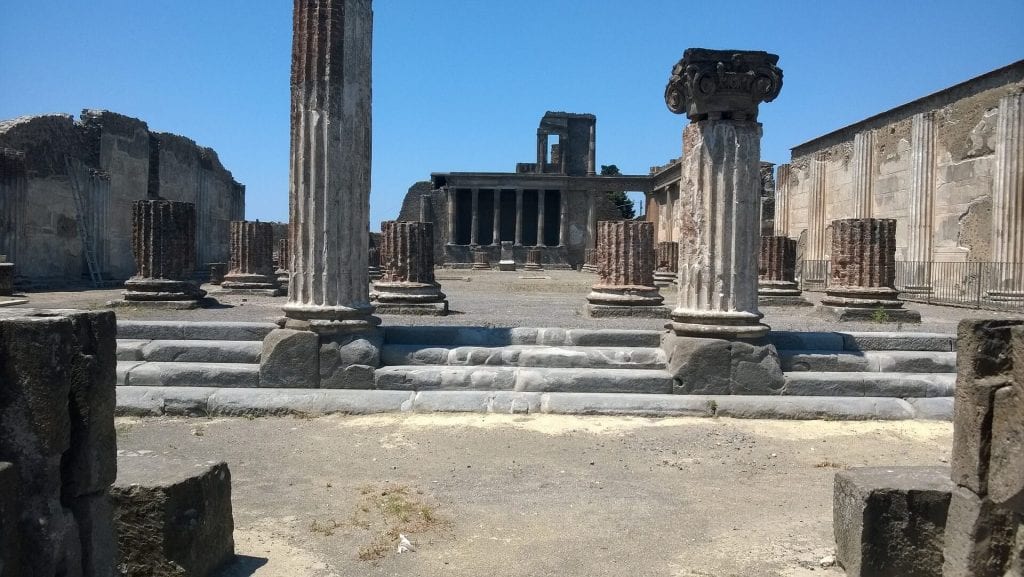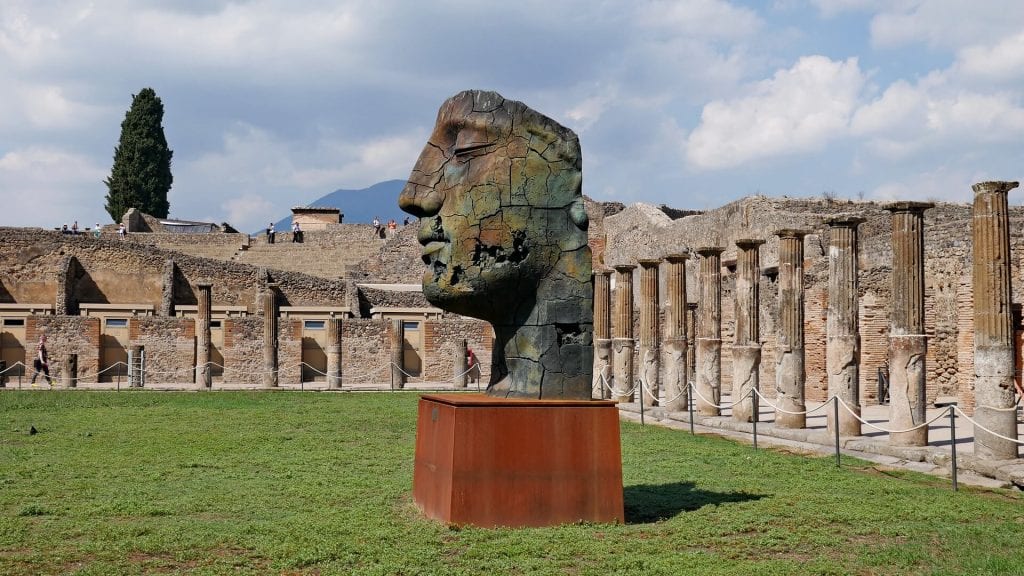Pompei is a city and comune in the Metropolitan City of Naples in Italy, home of the ancient Roman ruins part of the UNESCO World Heritage Sites.
The ancient Roman ruins of Pompeii
Pompeii was an ancient city located in what is now the comune of Pompei near Naples.
Largely preserved under the ash, the excavated city offered a unique snapshot of Roman life, frozen at the moment it was buried, and an extraordinarily detailed insight into the everyday life of its inhabitants, although much of the evidence was lost in the early excavations.

It was a wealthy town, enjoying many fine public buildings and luxurious private houses with lavish decorations, furnishings and works of art which were the main attractions for the early excavators. Organic remains, including wooden objects and human bodies, were entombed in the ash and decayed leaving voids which archaeologists found could be used as moulds to make plaster casts of unique and often gruesome figures in their final moments of life. The numerous graffiti carved on the walls and inside rooms provide a wealth of examples of the largely lost Vulgar Latin spoken colloquially at the time, contrasting with the formal language of the classical writers.
The first stable settlements on the site date back to the 8th century BC when the Oscans, a people of central Italy, founded five villages in the area.
With the arrival of the Greeks in Campania from around 740 BC, Pompeii entered the orbit of the Hellenic people and the most important building of this period is the Doric Temple, built away from the centre in what would later become the Triangular Forum.
At the same time the cult of Apollo was introduced. Greek and Phoenician sailors used the location as a safe port.
In the early 6th century BC, the settlement merged into a single community centred on the important crossroad between Cumae, Nola, and Stabiae and was surrounded by a tufa city wall (the pappamonte wall).
In 524 BC the Etruscans arrived and settled in the area, including Pompeii, finding in the River Sarno a communication route between the sea and the interior. Like the Greeks, the Etruscans did not conquer the city militarily, but simply controlled it and Pompeii enjoyed a sort of autonomy.
Nevertheless, Pompeii became a member of the Etruscan League of cities.
In 474 BC the Greek city of Cumae, allied with Syracuse, defeated the Etruscans at the Battle of Cumae and gained control of the area.
Pompeii was one of the towns of Campania that rebelled against Rome in the Social Wars and in 89 BC it was besieged by Sulla who targeted the strategically vulnerable Porta Ercolano with his artillery as can still be seen by the impact craters of thousands of ballista shots in the walls.
Many nearby buildings inside the walls were also destroyed. Although the battle-hardened troops of the Social League, Pompeii was forced to surrender after the conquest of Nola.
The result was that Pompeii became a Roman colony with the name of Colonia Cornelia Veneria Pompeianorum.
Many of Sulla’s veterans were given land and property in and around the city, while many of those who opposed Rome were dispossessed of their property. Despite this, the Pompeians were granted Roman citizenship and they were quickly assimilated into the Roman world.
The main language in the city became Latin, and many of Pompeii’s old aristocratic families Latinized their names as a sign of assimilation.
The city became an important passage for goods that arrived by sea and had to be sent toward Rome or southern Italy along the nearby Appian Way.
Many public buildings were built or refurbished and improved under the new order; new buildings included the amphitheatre in 70 BC, the Forum Baths and the theatrum tectum while the forum was embellished with the colonnade of Popidius before 80 BC. These buildings raised the status of Pompeii as a cultural centre in the region as it outshone its neighbours in the number of places for entertainment which significantly enhanced the social and economic development of the city.
Under Augustus from about 30 BC a major expansion in new public buildings, as in the rest of the empire, included the Eumachia building, the Sanctuary of Augustus and the Macellum. From about 20 BC, Pompeii was fed with running water by a spur from the Serino aqueduct or Aqua Augusta (Naples) built by Agrippa.
The inhabitants of Pompeii had long been used to minor earthquakes (indeed, the writer Pliny the Younger wrote that earth tremors “were not particularly alarming because they are frequent in Campania“), but on 5 February 62 a severe earthquake did considerable damage around the bay, and particularly to Pompeii. It is believed that the earthquake would have registered between about 5 and 6 on the Richter magnitude scale.
Between 62 and the Vesuvius eruption in 79 most rebuilding was done in the private sector and older, damaged frescoes were often covered with newer ones, for example. In the public sector the opportunity was taken to improve buildings and the city plan e.g. in the forum.
An important field of current research concerns structures that were restored between the earthquake of 62 and the eruption. It was thought until recently that some of the damage had still not been repaired at the time of the eruption but this has been shown to be doubtful as the evidence of missing forum statues and marble wall-veneers are most likely due to robbers after the city’s burial.
The public buildings on the east side of the forum were largely restored and were even enhanced by beautiful marble veneers and other modifications to the architecture.
Some buildings like the Central Baths were only started after the earthquake and were built to enhance the city with modern developments in their architecture, as had been done in Rome, in terms of wall-heating and window glass, and with well-lit spacious rooms.
The new baths took over a whole insula by demolishing houses, which may have been made easier by the earthquake that had damaged these houses. This shows that the city was still flourishing rather than struggling to recover from the earthquake.
In about 64 Nero and his wife Poppaea visited Pompeii and made gifts to the temple of Venus, probably when he performed in the theatre of Naples.
By 79 Pompeii had a population of 20,000, which had prospered from the region’s renowned agricultural fertility and favourable location.
Eruption oF Vesuvius in AD 79
The eruption lasted for two days. The first phase was of pumice rain (lapilli) lasting about 18 hours, allowing most inhabitants to escape.
That only approximately 1,150 bodies have so far been found on site seems to confirm this theory and most escapees probably managed to salvage some of their most valuable belongings; many skeletons were found with jewellery, coins and silverware.
A multidisciplinary volcanological and bio-anthropological study of the eruption products and victims, merged with numerical simulations and experiments, indicates that at Pompeii and surrounding towns heat was the main cause of death of people, previously believed to have died by ash suffocation.
The results of the study, published in 2010, show that exposure to at least 250 °C (480 °F) hot pyroclastic flows at a distance of 10 kilometres (6 miles) from the vent was sufficient to cause instant death, even if people were sheltered within buildings.
The people and buildings of Pompeii were covered in up to 12 different layers of tephra, in total up to 6 metres (19.7 ft) deep.
Pliny the Younger provided a first-hand account of the eruption of Mount Vesuvius from his position across the Bay of Naples at Misenum but written 25 years after the event.
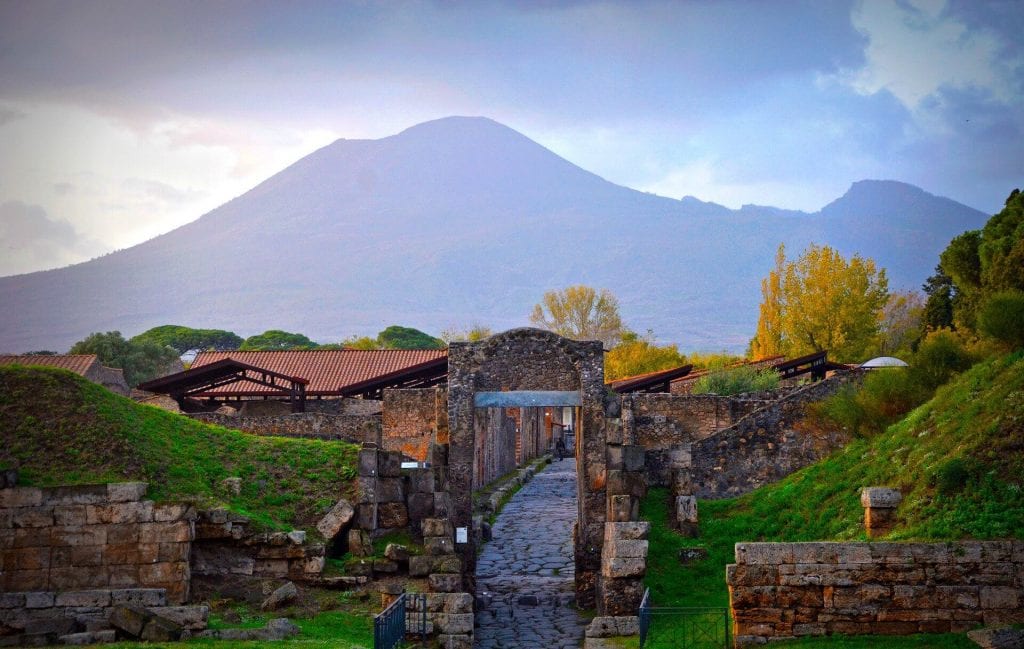
His uncle, Pliny the Elder, with whom he had a close relationship, died while attempting to rescue stranded victims. As admiral of the fleet, Pliny the Elder had ordered the ships of the Imperial Navy stationed at Misenum to cross the bay to assist evacuation attempts.
Volcanologists have recognised the importance of Pliny the Younger’s account of the eruption by calling similar events “Plinian“. It had long been thought that the eruption was an August event based on one version of the letter but another version gives a date of the eruption as late as 23 November.
A later date is consistent with a charcoal inscription at the site, discovered in 2018, which includes the date of 17 October and which must have been recently written.
Objects buried beneath Pompeii were well-preserved for almost 2,000 years as the lack of air and moisture allowed little to no deterioration. However, once exposed, Pompeii has been subject to both natural and man-made forces, which have rapidly increased deterioration.
Weathering, erosion, light exposure, water damage, poor methods of excavation and reconstruction, introduced plants and animals, tourism, vandalism and theft have all damaged the site in some way. The lack of adequate weather protection of all but the most interesting and important buildings has allowed original interior decoration to fade or be lost. Two-thirds of the city has been excavated, but the remnants of the city are rapidly deteriorating.
Furthermore, during World War II many buildings were badly damaged or destroyed by bombs dropped in several raids by the Allied forces.
Today, funding is mostly directed into conservation of the site; however, due to the expanse of Pompeii and the scale of the problems, this is inadequate in halting the slow decay of the materials.
A 2012 study recommended an improved strategy for interpretation and presentation of the site as a cost-effective method of improving its conservation and preservation in the short term.
In June 2013, UNESCO declared: If restoration and preservation works “fail to deliver substantial progress in the next two years” Pompeii could be placed on the List of World Heritage in Danger.

